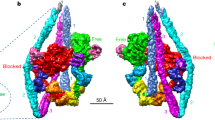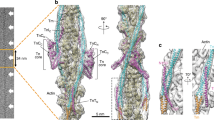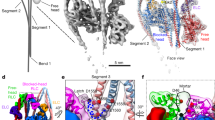Abstract
Studies of the interaction of proteolytic fragments of myosin with actin filaments in solution have indicated that the two heads of the myosin molecule1 can bind to adjacent subunits in the same actin filament2,3. However, geometrical considerations led Offer and Elliott4 to the conclusion that in the highly ordered filament lattice present in insect flight muscle, tighter binding would occur if the two heads bound to different actin filaments. Indeed, rigidity measurements5, electron microscope observations6 and superprecipitation experiments7 support the idea that heavy meromyosin (HMM), the double-headed myosin fragment, can cross-link actin filaments in solution. We now provide an experimental demonstration of the cross-linking of thin filaments in muscle by double-headed myosin species. In striated muscle, the thin filament lattice can be stabilized by either the Z-bands or complex formation with myosin. Removal of the Z-bands by a proteolytic enzyme8 or extraction of myosin, leaves the actin-containing I-bands intact. However, if both Z-bands and myosin are removed, the I-bands should disintegrate into single, dispersed, filaments. We found that this could be prevented by preincubation with HMM, but the single -headed HMM subfragment-1 (HMM S-l) was totally ineffective. This strongly suggests that the stabilization by HMM of the filamentous lattice is a result of inter-filament cross-linking.
This is a preview of subscription content, access via your institution
Access options
Subscribe to this journal
Receive 51 print issues and online access
$199.00 per year
only $3.90 per issue
Buy this article
- Purchase on Springer Link
- Instant access to full article PDF
Prices may be subject to local taxes which are calculated during checkout
Similar content being viewed by others
References
Slayter, H. S. & Lowey, S. Proc. natn. Acad. Sci. U.S.A. 58, 1611–1618 (1967).
Moore, P. B., Huxley, H. W. & De Rosier, D. J. J. molec. Biol. 50, 279–295 (1970).
Craig, R. C. et al. J. molec. Biol. 140, 35–55 (1980).
Offer, G. & Elliot, A. Nature 271, 325–329 (1978).
Abe, S. I. & Maruyama, K. Biochim. biophys. Acta 160, 160–172 (1974).
Trinick, J., & Offer, G. J. molec. Biol. 133, 549–556 (1979).
Borejdo, J., Garty, N., Shimon, T., Himmelhoch, S. & Oplatka, A. FEBS Lett. 105, 101–104 (1979).
Goll, D. E. et al. J. Anim. Sci. 33, 963–982 (1971).
Weeds, A. G. & Pope, B. J. molec. Biol. 111, 129–157 (1977).
Borejdo, J. & Assulin, O. Biochemistry 19, 4913–4921 (1980).
Author information
Authors and Affiliations
Rights and permissions
About this article
Cite this article
Borejdo, J., Oplatka, A. Heavy meromyosin cross-links thin filaments in striated muscle myofibrils. Nature 291, 322–323 (1981). https://doi.org/10.1038/291322a0
Received:
Accepted:
Issue Date:
DOI: https://doi.org/10.1038/291322a0
This article is cited by
-
Three-dimensional reconstruction of rigor insect flight muscle from tilted thin sections
Nature (1984)
-
Geometrical constraints affecting crossbridge formation in insect flight muscle
Journal of Muscle Research and Cell Motility (1984)
-
Motion of myosin filaments due to interaction of the two-headed myosin crossbridge with two actin filaments
Journal of Muscle Research and Cell Motility (1984)
Comments
By submitting a comment you agree to abide by our Terms and Community Guidelines. If you find something abusive or that does not comply with our terms or guidelines please flag it as inappropriate.



